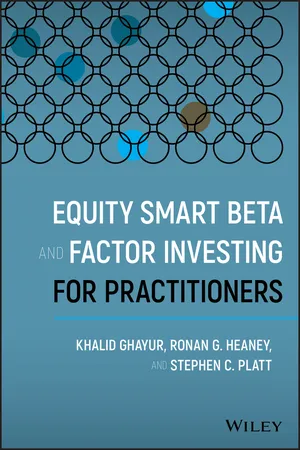
Equity Smart Beta and Factor Investing for Practitioners
- English
- ePUB (mobile friendly)
- Available on iOS & Android
Equity Smart Beta and Factor Investing for Practitioners
About this book
A guide to the popular and fast growing investment opportunities of smart beta
Equity Smart Beta and Factor Investing for Practitioners offers a hands-on guide to the popular investment opportunities of smart beta, which is one of the fastest growing areas within the global equity asset class. This well-balanced book is written in accessible and understandable terms and contains an in-depth manual filled with analytical information and new ideas.
The authors—noted experts in the field—include a definition of smart beta investing and detail its history. They also explore the distinguishing characteristics of smart beta strategies, offer an overview of factor investing, and reveal the implementation of smart beta approaches. Comprehensive in scope, the book contains helpful examples of applications, real-life illustrative case studies, and contributions from leading and respected practitioners that explain how they approach smart beta investing. This important book:
- Contains an in-depth exploration of smart beta investing
- Includes the information written in clear and accessible language
- Presents helpful case studies, illustrative examples, and contributions from leading and respected experts
- Offers a must have resource coauthored by the Head of Goldman Sachs' equity smart beta business
Written for investors who want to tap into the opportunities that smart beta offers, Equity Smart Beta and Factor Investing for Practitioners is the comprehensive resource for learning how to create more efficient overall equity portfolios.
Frequently asked questions
- Essential is ideal for learners and professionals who enjoy exploring a wide range of subjects. Access the Essential Library with 800,000+ trusted titles and best-sellers across business, personal growth, and the humanities. Includes unlimited reading time and Standard Read Aloud voice.
- Complete: Perfect for advanced learners and researchers needing full, unrestricted access. Unlock 1.4M+ books across hundreds of subjects, including academic and specialized titles. The Complete Plan also includes advanced features like Premium Read Aloud and Research Assistant.
Please note we cannot support devices running on iOS 13 and Android 7 or earlier. Learn more about using the app.
Information
PART I
OVERVIEW OF EQUITY SMART BETA SPACE
Chapter 1
Evolution and Composition of the Equity Smart Beta Space
Chapter Summary
- The origins of smart beta investing can potentially be traced back to research investigating the shortcomings of the capitalization-weighted market indexes. These efforts and the identified shortcomings led researchers to investigate alternative non-capitalization-weighted methodologies, such as equal-weighting, minimum variance, and fundamental weighting.
- Empirical analysis of products based on these alternative weighting methodologies depicted higher risk-adjusted returns (Sharpe ratios) compared to the market index, thereby suggesting that the capitalization-weighted market index may not be as efficient as theory (the Capital Asset Pricing Model, or CAPM) would suggest.
- These products were initially referred to as alternative equity betas in the academic literature. Today, the term “smart beta” is commonly used in reference to such strategies.
- Risk decomposition analyses of alternative equity beta strategies revealed that these strategies derive much of their market outperformance through high exposures to equity common factors, such as size, low volatility, or value, which have been well documented in the academic literature over several decades.
- As such, in our experience, investor focus shifted to capturing the equity common factors more directly and/or in a more customizable benchmark-aware implementation (an active beta perspective), which does not require replacing the capitalization-weighted market index as the policy benchmark (an alternative beta perspective).
- The composition of the smart beta space, therefore, evolved from alternative equity beta strategies to a combination of alternative beta and various factor offerings.
- The risk decomposition of alternative equity beta strategies also shows that, at least in terms of investment outcome, smart beta can be defined as mostly factor investing, as the continued success of alternative equity beta strategies critically depends on the persistence of various factor premia.
- Factor investing is not new both from a passive as well as an active implementation perspective. What is new with regard to smart beta strategies, however, is a value-adding repackaging of factor investing. Smart beta strategies create a hybrid solution that retains the attractive features of both passive and active management. Such strategies offer characteristics that emphasize efficiency, transparency, low turnover, improved diversification and capacity, and low fees.
I. Introduction
II. Evolution of Equity Smart Beta
A. Benefits of Capitalization Weighting
B. Potential Drawbacks of Capitalization Weighting
C. Suggested Solutions
Table of contents
- Cover
- Title Page
- Copyright
- Acknowledgments
- Disclaimer
- Introduction
- PART I OVERVIEW OF EQUITY SMART BETA SPACE
- PART II EQUITY COMMON FACTORS AND FACTOR INVESTING
- PART III CAPTURING SMART BETA FACTORS
- PART IV PERFORMANCE CHARACTERISTICS OF SMART BETA FACTOR STRATEGIES
- PART V SMART BETA IMPLEMENTATION
- PART VI ASSET OWNER PERSPECTIVES
- PART VII CONSULTANT PERSPECTIVES
- PART VIII RETAIL PERSPECTIVES
- PART IX CONCLUDING REMARKS
- About the Authors
- Bibliography
- Additional Disclaimers
- Index
- End User License Agreement